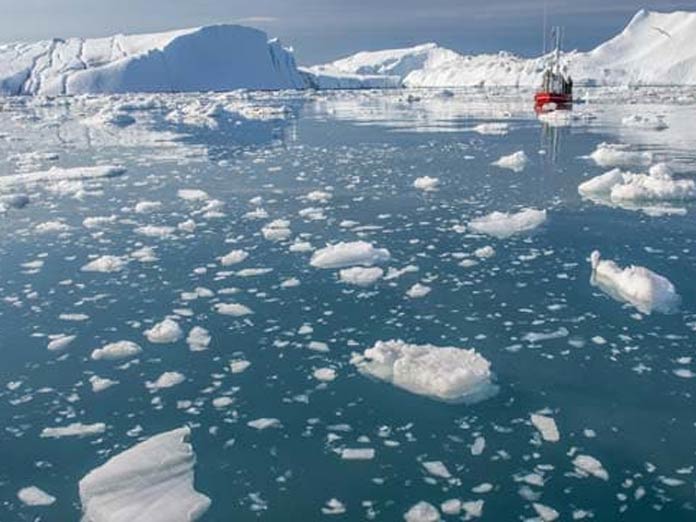Live
- Mercedes-Benz India to Launch 8 New Models, Focus on EVs in 2025
- Collector Inspects EVM Godown in Nagarkurnool
- Devotees' Tragic Demise in Tirumala Stampede: Chakravarthy Acharyulu Expresses Deep Condolences
- Disability can be identified and prevented in the early stages -DMHO Dr. K.V. Swarajya Lakshmi
- Ram Charan's 'Game Changer' Set for Big Box Office Debut
- Scientists Provide Training to Farmers on Integrated Farming
- SP Gaikwad Launches Feedback QR Code Poster for Police Services Opinion
- Helping Hands Charitable Trust Distributes Study Material to 3,000 Students in Gattu Mandal
- Samajwadi Party Strengthens Leadership in Telangana and Andhra Pradesh
- Poco X7 5G and Poco X7 Pro 5G Launched in India: Price, Specifications, and Features
Just In

The Greenland ice sheet is melting four times faster than in 2003 due to continued, accelerating warming of the Earths atmosphere, and may lead to faster rise in the sea level, according to a study
Washington: The Greenland ice sheet is melting four times faster than in 2003 due to continued, accelerating warming of the Earth's atmosphere, and may lead to faster rise in the sea level, according to a study.
Scientists concerned about sea level rise have long focused on Greenland's southeast and northwest regions, where large glaciers stream iceberg-sized chunks of ice into the Atlantic Ocean. The study, published in the journal Proceedings of the National Academy of Sciences, found that the largest sustained ice loss from early 2003 to mid-2013 came from Greenland's southwest region, which is mostly devoid of large glaciers. "Whatever this was, it couldn't be explained by glaciers, because there are not many there," said Michael Bevis, a professor at The Ohio State University in the US. "It had to be the surface mass -- the ice was melting inland from the coastline," Bevis said.
That melting, which researchers believe is largely caused by global warming, means that in the southwestern part of Greenland, growing rivers of water are streaming into the ocean during summer. Southwest Greenland, which previously had not been considered a serious threat, will likely become a major future contributor to sea level rise, researchers said. "We knew we had one big problem with increasing rates of ice discharge by some large outlet glaciers," he said. "But now we recognise a second serious problem: Increasingly, large amounts of ice mass are going to leave as meltwater, as rivers that flow into the sea," Bevis said.
The findings could have serious implications for island nations that are particularly vulnerable to rising sea levels, researchers said. "The only thing we can do is adapt and mitigate further global warming -- it is too late for there to be no effect. This is going to cause additional sea level rise. We are watching the ice sheet hit a tipping point," Bevis said. GRACE or Gravity Recovery and Climate Experiment involves twin satellites that measure ice loss across Greenland. Data from these satellites showed that between 2002 and 2016, Greenland lost about 280 gigatonnes of ice per year, equivalent to 0.03 inches of sea level rise each year. However, the rate of ice loss across the island was far from steady.
The team used data from GRACE and from Global Positioning System (GPS) stations scattered around Greenland's coast to identify changes in ice mass. The patterns they found show an alarming trend -- by 2012, ice was being lost at nearly four times the rate that prevailed in 2003, researchers said. This acceleration was focused in southwest Greenland, a part of the island that previously hadn't been known to be losing ice that rapidly, they said. Bevis said a natural weather phenomenon -- the North Atlantic Oscillation, which brings warmer air to West Greenland, as well as clearer skies and more solar radiation -- was building on man-made climate change to cause unprecedented levels of melting and runoff. Global atmospheric warming enhances summertime melting, especially in the southwest.
The North Atlantic Oscillation is a natural cycle that causes ice to melt under normal circumstances. When combined with man-made global warming, though, the effects are supercharged. "These oscillations have been happening forever. So why only now are they causing this massive melt? It's because the atmosphere is, at its baseline, warmer," Bevis said. "The transient warming driven by the North Atlantic Oscillation was riding on top of more sustained, global warming," he said.

© 2025 Hyderabad Media House Limited/The Hans India. All rights reserved. Powered by hocalwire.com







